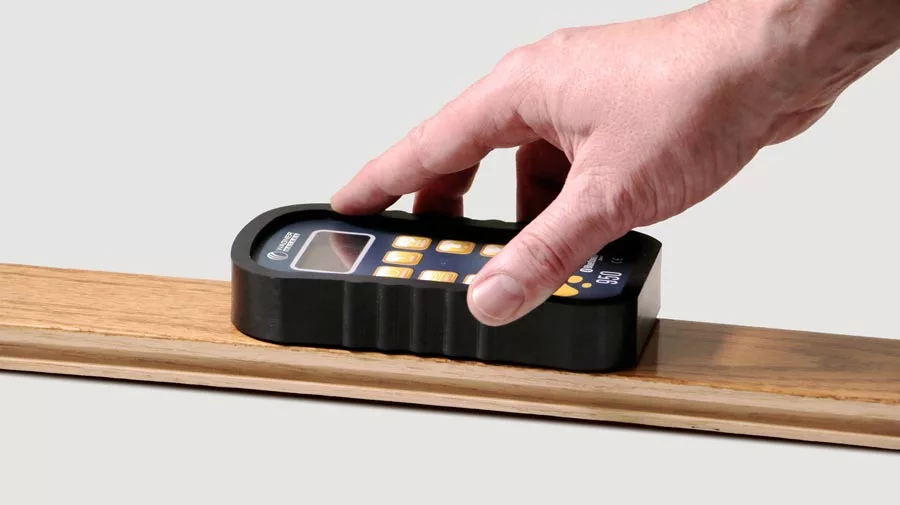Understanding Equilibrium Moisture Content for Hardwood Floor Installations

The Orion 950 pinless moisture meters measures equilibrium moisture content.
Photo: Wagner Meters.
Controlling the moisture content (MC) of your floors is central not only to a successful installation but also to the longevity of your clients’ floors. But the MC of your hardwood flooring planks is actually not very helpful without the equilibrium moisture content (EMC) of a given location.
That’s why this article is all about the importance of understanding EMC and knowing what equipment or calculations you’ll need to find it.
Keep reading to learn:
- What EMC is
- Why it matters for flooring installations
- The #1 product you need for successful flooring installations
First, let’s start with the basics.
Equilibrium moisture content, or EMC for short, is when the wood and its environment have reached a point where moisture is no longer exchanged. In other words, the wood no longer absorbs or releases moisture because the amount of moisture in the wood is the same amount in the environment.
When the wood’s MC matches the EMC of a given location, the wood is stable. It doesn’t shrink or expand with moisture. More on that in a moment.
EMC is impacted by the temperature and relative humidity of a space, and while each space can technically have its own EMC, there are general numbers for specific regions across North America. For example, according to the Moisture Map of North America, the EMC of Florida is 12–13% and the EMC of Nevada is 4–7%.
There are actual equations used to calculate the EMC of an area. The first reasonably estimates the EMC:
EMC = [ -ln (1 – ϕ) / 4.5 x 10-5 ( T + 460 ) ] 0.638
where
ln = natural logarithm (a mathematical equation that calculates the time it takes to reach a specified point)
ϕ = relative humidity expressed as a decimal
T = temperature in Fahrenheit
However, there is a more complex and complicated equation—the Hailwood-Horrobin equation—that can be used for more accurate results:
Meq = ( 1800 / W ) * ( (kh) / (1 – kh) + ( k1kh + 2k1k2k2h2 ) / ( 1 + k1kh + k1k2k2h2 ) )
where
Meq = the %EMC
T = temperature in Fahrenheit
h = the fractional relative humidity
W = 330 + 0.452T + 0.00415T2
k = 0.791 + 4.63*10-4T – 8.44*10-7T2
k1 = 6.34 + 7.75*10-4T – 9.35*10-5T2
k2 = 1.09 + 2.84*10-2T – 9.04*10-5T2
If your head is spinning from all these numbers, you’re not alone. We feel the same way. These formulas are definitely not the easiest, most efficient way to calculate EMC.
Thankfully, we have a product that does it all for you in real time. But we’ll get to that in a second. For now, let’s talk about why EMC should matter to you as a flooring professional.
Why Does EMC Matter for Wood Flooring Installers?
Flooring installers can’t install a wood floor without risk until the MC of the wood planks and the EMC of the installation location match.
Why?
It’s all because wood is a hygroscopic material. This means that the wood will absorb or release moisture depending on its environment.
If the environment has more moisture than the wood, then the wood will absorb that moisture and expand. If, on the other hand, the environment is drier than the wood, then the wood will release moisture into the air and contract.
This might not sound like a big deal, but the expansions and contractions of wood can actually be detrimental to flooring. Anything beyond normal seasonal shifts can cause all kinds of moisture-related issues.
Things like:
- Cupping
- Crowning
- Warping
- Buckling
And if the floors you’ve installed exhibit any of these issues, the responsibility immediately goes to you, the flooring installer. Not only does caring about EMC ensure long-lasting, high-quality flooring, but it also protects your reputation.

Photo: Wagner Meters.
If EMC is so important, then how do you make sure the MC of the flooring and the EMC of the space match up? Well, the key is to use a product that can do it all for you.
Unlike many pinless moisture meters out there, the Orion 950 can measure MC and EMC. This means you don’t even have to think about those crazy formulas listed above.
So, how can you use the Orion 950 for flooring success? First, use it when selecting wood floors. Measure the MC of the planks and compare that measurement to the EMC of the installation location. Is the measurement within a few percentage points? If so, then you know that, after a short acclimation, the flooring will be ready for installation.
You can also use it throughout the installation process to ensure the floors are properly acclimating to the EMC. If they aren’t, you can make necessary changes to the space to help the wood along, like ensuring that the building is enclosed or using fans and dehumidifiers/humidifiers.
While you can let the floors sit in the installation location for several days and hope that the MC and EMC numbers are close, the only way you can know for sure is by measuring the MC and calculating the EMC. And once you know, you can install with confidence and not worry about the terrors of moisture damage looming over you.
Get more installation tips and how-to's!
If you want the confidence of wood flooring success and the pride that comes with a great reputation and a job well done, the Orion 950 pinless moisture meter will get you there. Add one to your installation workflow today and be the flooring installer that clients want to hire.
Looking for a reprint of this article?
From high-res PDFs to custom plaques, order your copy today!





